The Bureau of Land Reclamation built Cachuma Lake in 1953, along the Santa Ynez River in Santa Barbara County. Although it was primarily built as a water supply for the region, the lake is also a popular recreational destination. Thousands of people visit the area annually, taking advantage of camping, boating, fishing, and hiking available.
Building the reservoir was also terrific for wildlife. Dozens of animal species live in and around Cachuma Lake, including these nine different snakes.
San Diego Gopher Snake (Pituophis catenifer annectens)

Gopher snakes are often mistaken for
rattlesnakes
because of their defensive display.
©Tim Pleasant/Shutterstock.com
This gopher snake subspecies occurs from southern California’s coastal mountains to the coast. San Diego gopher snakes average between four and five feet long and have dark reddish-brown dorsal blotches connected on the sides like a chain (catenifer means chainlike) over a lighter base color.
These snakes eat various prey from lizards to rats and pocket gophers. However, their defensive tactics are fairly dramatic! All gopher snakes puff themselves up and do their best rattlesnake imitation by hissing and rattling their tail against the ground. If they strike at you, it is often with a closed mouth.
California Kingsnake (Lampropeltis californiae)
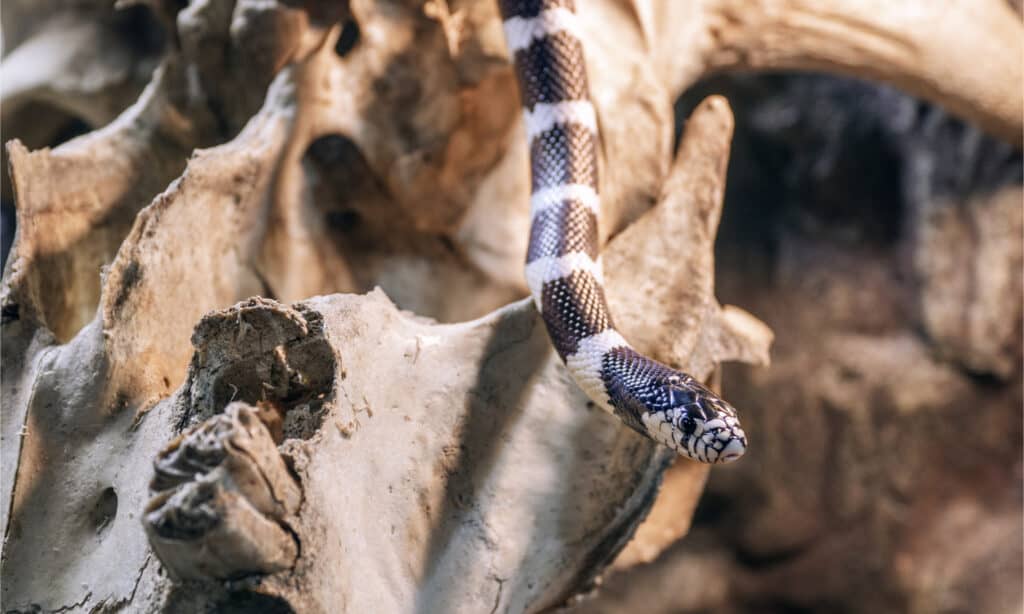
California kingsnakes are available in many colors, the most common is alternating dark and light bands.
©Ann May Snz/Shutterstock.com
These kingsnakes are extremely variable in the wild — one individual may have black and white bands, while another is solid black. California kingsnakes are popular pets because of their natural variability and easy-going temperament.
However, the California kingsnakes around Lake Cachuma are more interested in eating small rodents, lizards, and even rattlesnakes than in becoming your pet. Kingsnakes are harmless to humans, but efficient predators that keep rodents and even other snake populations in check.
Monterey Ring-Necked Snake (Diadophis punctatus vandenburgii)
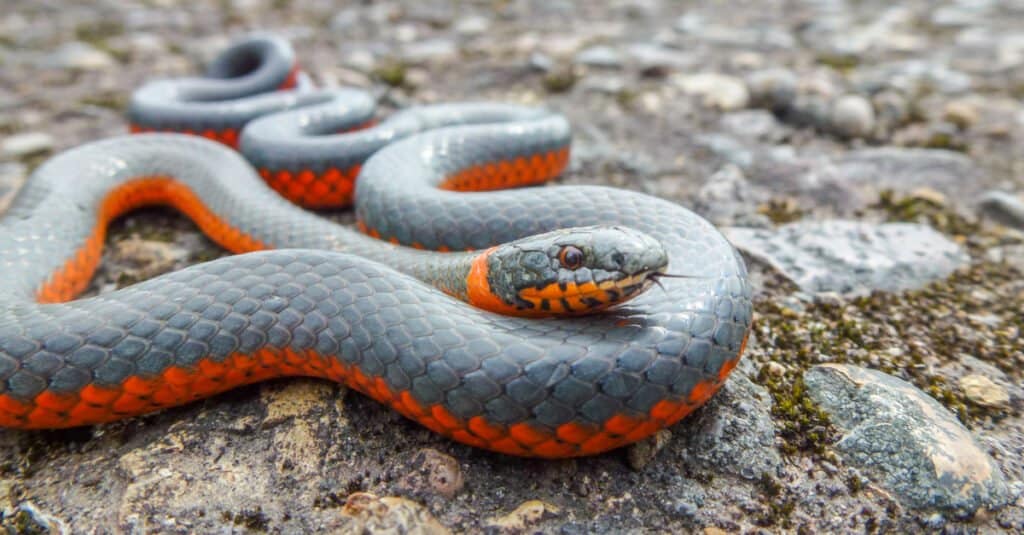
Ring-neck snakes around Lake Cachuma are typical of the species.
©Tom Fenske/Shutterstock.com
There are approximately 14 recognized ring-necked snake subspecies — their appearance is remarkably similar across their extensive North American range.
The ring-neck snakes around Lake Cachuma are typical of the Monterey ring-neck snake subspecies with a bright red to orange belly and matching neck ring. Most of them measure 10-15 inches as adults and use moist leaf litter and rotten logs as shelter when they aren’t hunting salamanders, slugs, and other small creatures.
Common Garter Snake (Thamnophis sirtalis)

Garter snakes are semiaquatic and are never far from a permanent water source.
©iStock.com/Wildnerdpix
This semiaquatic snake is probably the most cold-adapted snake species in North America. It doesn’t live quite as far north as Europe’s common adder but still manages to survive in frigid areas of Canada.
However, the common garter snake does not have to contend with that level of cold around Lake Cachuma — the lake’s mild climate makes it quite comfortable for much of the year. Garter snakes are never far from water. They eat earthworms, amphibians, and sometimes small fish.
Two-Striped Garter Snake (Thamnophis hammondii)

Two-striped garter snakes are highly aquatic and have two variants — this one shows the checkered pattern.
©Jason Mints/Shutterstock.com
Even more aquatic than its common garter snake cousin, the two-striped garter snake prefers wet habitats with a permanent water source. They eat fish and amphibians like frogs and salamanders.
Growing up to 30 inches long, the two-striped garter snake has two natural variants — a checkered variant, and a striped one. The striped variant has one stripe on each side of its body, while the checkered form has small dots in a checkered pattern where the stripes would have been.
Coast Mountain Kingsnake (Lampropeltis multifasciata)
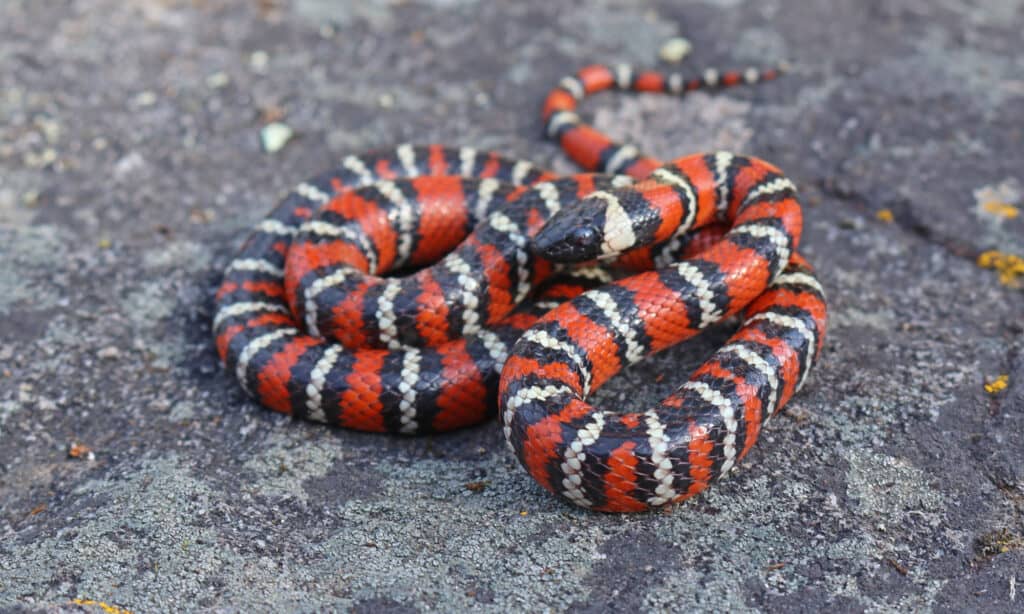
Coast mountain kingsnakes have beautiful red, black, and white bands.
©Creeping Things/Shutterstock.com
This nonvenomous constrictor is banded from its neck to its tail in red, white, and black. Coast mountain kingsnakes are thick and muscular, with shiny scales and heads that are about the same size as their necks. Like their cousins, they eat anything they can catch — including other snakes.
These diurnal hunters can be seen around Cachuma Lake, slithering from one hiding place to another.
California Whipsnake (Masticophis lateralis)

Striped racers have been known to reach 6 feet, but most average around five feet.
©Matt Jeppson/Shutterstock.com
Racers and whipsnakes are fun snakes. They move really fast, often over four miles per hour — which does not sound like much, but when you cannot fly and have no legs, it is impressive.
This snake is endemic to California and northern Baja California. It boasts a bright yellow racing stripe on each side of its body against a dark background — growing up to about four feet long and very thin. California whipsnakes eat a variety of prey and have a strong preference for lizards. They thrive around Cachuma Lake because of the rocky, rough terrain that makes great hiding places for their favorite foods.
Coast Garter Snake (Thamnophis elegans terrestris)
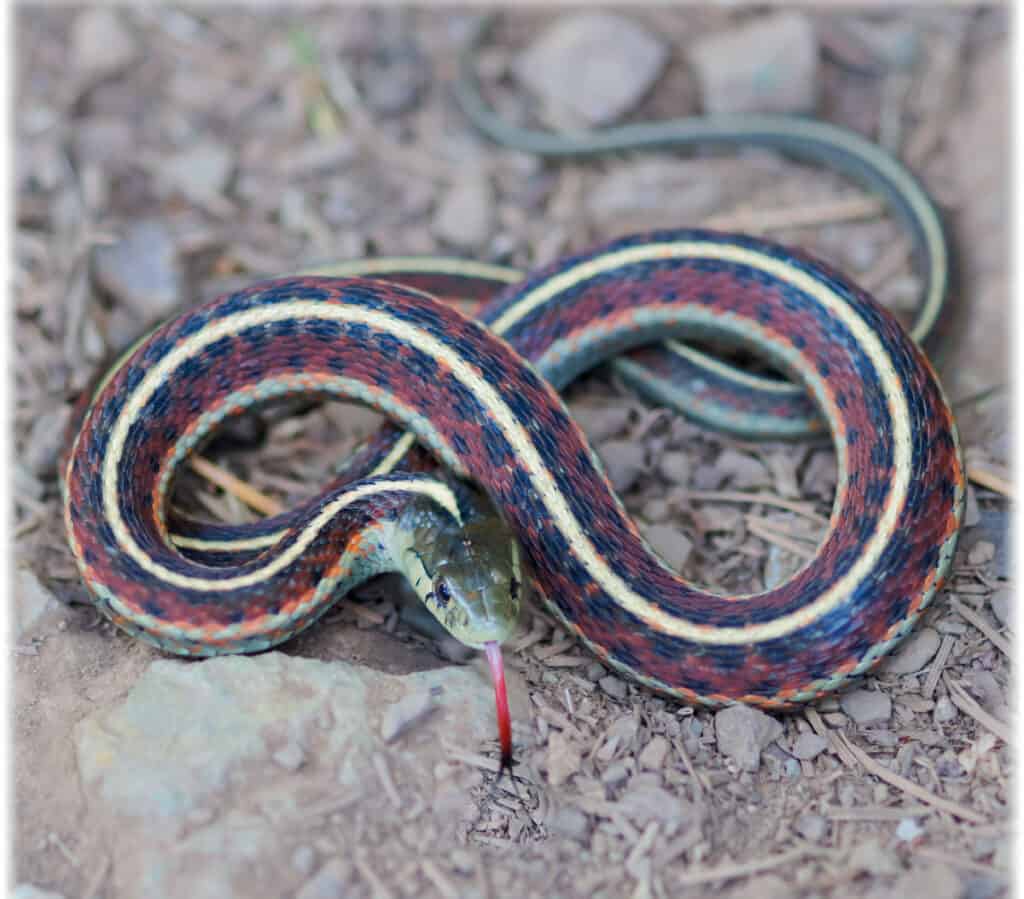
Coast garter snakes are highly variable and have many different color phases. Some even have a red dorsal stripe, but most are yellow.
©iStock.com/yhelfman
This western terrestrial garter snake subspecies occurs from northern Baja California to southern Oregon. While nearly every other garter snake species stays close to water, western terrestrial garter snakes and their subspecies, like the coast garter snake, are more flexible with their location. These snakes are often found miles from a water source, and their diet is equally flexible. Coast garter snakes eat what is available. Everything from tadpoles and amphibians to leeches, earthworms, and even small rodents.
Coast garter snakes vary widely in color and pattern. Most have a bright yellow dorsal stripe and a yellowish lateral stripe on each side. However, some have red dorsal stripes — you just never know with coast garter snakes. Garter snakes, in general, make positive identification more difficult than many species.
There are not as many recorded sightings of coast garter snakes around Cachuma Lake as further north, but it is at the southern edge of their range.
Coast Night Snake (Hypsiglena ochrorhynchus)
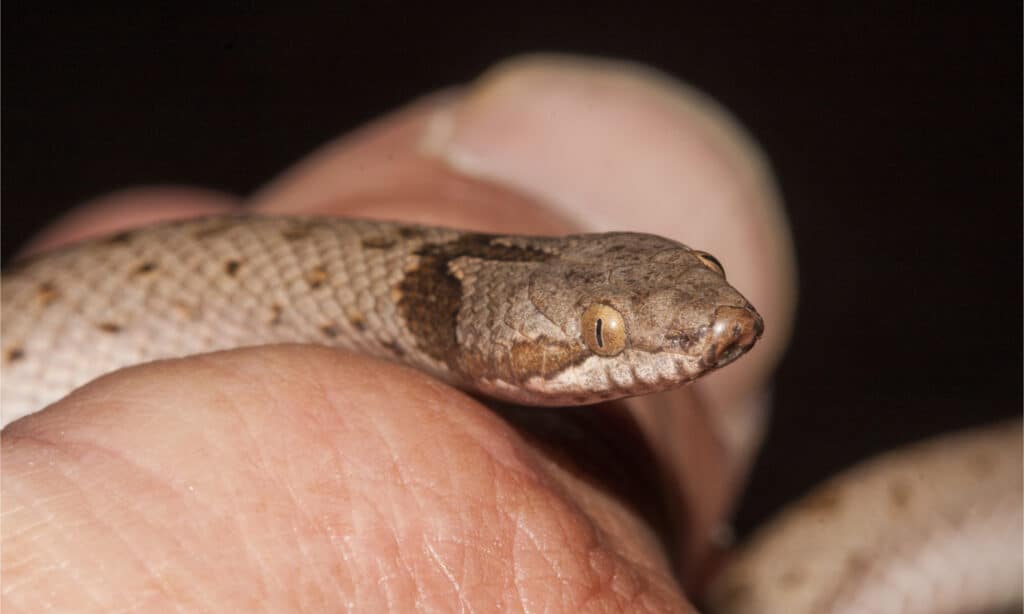
Night snakes have vertical pupils and are only about 12 inches long.
©Viktor Loki/Shutterstock.com
Night snakes are small nocturnal colubrids that are mildly venomous. They are harmless to people, but their venom affects the small animals they prey upon for food. There are about nine species spread across the western United States, and many look similar — usually if you have seen one, you can at least tell that you are looking at a night snake.
Coast night snakes eat various small lizards and frogs, so are commonly found near water like Lake Cachuma.
Southern Pacific Rattlesnake (Crotalus helleri)

Southern Pacific rattlesnakes are endemic to southern California and Baja California.
©Audrey Snider-Bell/Shutterstock.com
Once considered a western rattlesnake subspecies, the southern Pacific rattlesnake’s description changed after genetic testing showed they deserve species status. These venomous pit vipers range from just north of Santa Barbara south to northern Baja California, Mexico. They are relatively common around Lake Cachuma, but only venture into the water when they must.
Southern Pacific rattlesnakes have a blotched dorsal pattern that becomes bands toward the tail and a lighter gray to brown base color. They are highly venomous, but not particularly aggressive snakes that eat rodents and other small animals.
Rattlesnake Bite First-Aid
Although as many as 25% of all rattlesnake bites are dry, where the snake does not inject venom, a rattlesnake bite is a medical emergency. If you are bitten, the following steps can minimize any damage the venom causes.
- Don’t panic! Stay calm while you head to the hospital.
- Clean the bite and cover with a bandage.
- Remove tight-fitting clothing and jewelry.
- Keep the body part bitten below your heart.
- Do NOT use tourniquets.
- Do NOT cut or try to suck out the venom.
- Do NOT take blood-thinning painkillers or drink alcohol.
Of the 7,000 to 8,000 venomous snakebites in the United States annually, only about five result in death — most people recover fully.
Other Animals Around Cachuma Lake
Snakes are not the only animals lurking around Lake Cachuma! The region is full of wildlife, including hawks, gulls, deer, and coyotes.
However, the area is a birdwatching bonanza — here are a few birds you may spot around the lake.
- Acorn Woodpecker (Melanerpes formicivorus)
- Lesser Goldfinch (Spinus psaltria)
- Anna’s Hummingbird (Calypte anna)
- California Towhee (Melozone crissalis)
- Yellow-billed Magpie (Pica nuttalli)
What to Do About Animal Encounters
In most cases, animals avoid us clumsy humans and our pooches. So, simply giving it enough space that it can retreat safely is typical enough to avoid a conflict. However, sometimes a rattler finds its way into an area where lots of people frequent.
Local park rangers are usually the best option for removing a snake from campsites. They can be contacted at (805) 686-5055
The photo featured at the top of this post is © Belyay/Shutterstock.com
Discover the "Monster" Snake 5X Bigger than an Anaconda
Every day A-Z Animals sends out some of the most incredible facts in the world from our free newsletter. Want to discover the 10 most beautiful snakes in the world, a "snake island" where you're never more than 3 feet from danger, or a "monster" snake 5X larger than an anaconda? Then sign up right now and you'll start receiving our daily newsletter absolutely free.
Thank you for reading! Have some feedback for us? Contact the AZ Animals editorial team.






